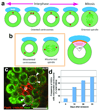Centrosome misorientation reduces stem cell division during ageing
- PMID: 18923395
- PMCID: PMC2712891
- DOI: 10.1038/nature07386
Centrosome misorientation reduces stem cell division during ageing
Abstract
Asymmetric division of adult stem cells generates one self-renewing stem cell and one differentiating cell, thereby maintaining tissue homeostasis. A decline in stem cell function has been proposed to contribute to tissue ageing, although the underlying mechanism is poorly understood. Here we show that changes in the stem cell orientation with respect to the niche during ageing contribute to the decline in spermatogenesis in the male germ line of Drosophila. Throughout the cell cycle, centrosomes in germline stem cells (GSCs) are oriented within their niche and this ensures asymmetric division. We found that GSCs containing misoriented centrosomes accumulate with age and that these GSCs are arrested or delayed in the cell cycle. The cell cycle arrest is transient, and GSCs appear to re-enter the cell cycle on correction of centrosome orientation. On the basis of these findings, we propose that cell cycle arrest associated with centrosome misorientation functions as a mechanism to ensure asymmetric stem cell division, and that the inability of stem cells to maintain correct orientation during ageing contributes to the decline in spermatogenesis. We also show that some of the misoriented GSCs probably originate from dedifferentiation of spermatogonia.
Figures






Comment in
-
Stem cells: Makeshift sperm production.Nature. 2008 Dec 4;456(7222):583-5. doi: 10.1038/456583a. Nature. 2008. PMID: 19052613 No abstract available.
References
Publication types
MeSH terms
Grants and funding
LinkOut - more resources
Full Text Sources
Other Literature Sources
Medical
Molecular Biology Databases

